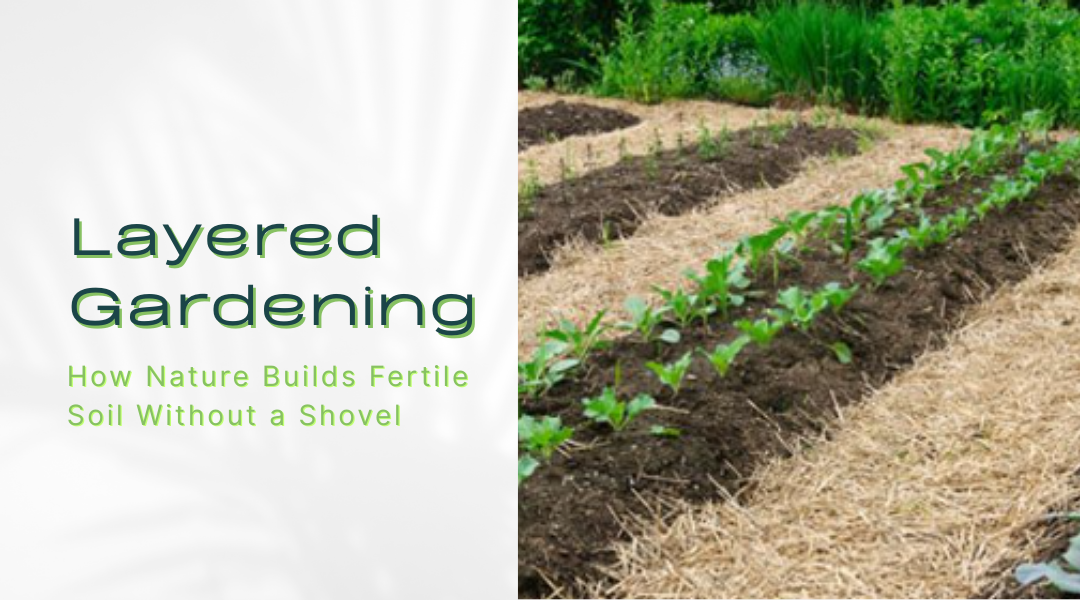If you’ve ever dreamed of a garden that practically takes care of itself, layered gardening—often nicknamed “lasagna gardening”—might just be your new best friend. Despite the playful name, this technique involves no pasta or cheese, only the rich, earthy materials nature provides. At its core, layered gardening is about working with natural processes to create nutrient-packed soil, without ever digging, tilling, or stressing about weeds.
This method is all about letting decomposition do the heavy lifting while you simply provide the right ingredients. To truly understand why it works so well, we need to explore the science behind the layers, the microscopic workers in your soil, and the magic that transforms everyday scraps into thriving plant nourishment.
Nature’s Secret Blueprint: How Layered Gardening Works
Imagine walking through a forest. Look down at the forest floor: a thick blanket of leaves, fallen branches, and decaying plants carpets the soil. Beneath your feet, a microscopic workforce of bacteria, fungi, and earthworms is hard at work, transforming this organic mess into dark, fertile soil. Layered gardening recreates this ecosystem in your backyard.
Instead of starting with bare soil and digging furiously, you build your garden from the ground up, layering materials that naturally break down over time. Each layer contributes to soil fertility, moisture retention, and the overall health of your plants. By mimicking nature’s approach, your garden becomes self-sustaining—a living system that supports itself with minimal effort from you.
The Magic of Decomposition: Turning Waste into Wealth
At the heart of layered gardening is decomposition—the process by which organic materials break down into humus, a rich, dark substance teeming with nutrients. The materials you layer, from vegetable scraps to shredded cardboard, don’t just vanish; they undergo a transformation guided by a complex web of soil life.
Microbes: The Invisible Workforce
Tiny but mighty, microbes are the first responders in this process. These include bacteria and actinomycetes—specialized bacteria that tackle tougher materials like straw or cardboard.
- Bacteria thrive on softer, nitrogen-rich items such as food scraps and grass clippings, rapidly converting them into nutrients plants can use.
- Actinomycetes handle the heavier, carbon-rich materials, breaking them down slowly to provide a steady release of nutrients over time.
These microbial communities not only recycle nutrients but also improve soil structure, making it looser, more aerated, and better able to hold water. Research from the Soil Science Society of America confirms that healthy microbial activity is essential for productive, fertile soil.
Fungi: The Hidden Architects
Fungi often go unnoticed, yet their role is critical. They decompose stubborn materials like wood fibers and create networks called mycorrhizae that connect plant roots. These underground “highways” help plants access water, nutrients, and even communicate about potential threats from pests or disease. The result is stronger, more resilient plants capable of thriving in varied conditions.
Earthworms: Nature’s Plow
Finally, there are the earthworms—the unsung heroes of any garden. As they burrow through your layered soil, they aerate it, improve drainage, and leave behind nutrient-rich castings. Studies show that gardens teeming with earthworms can see increases in soil fertility and crop yields of up to 25%. Their movement also helps roots penetrate deeply, giving plants the support they need to flourish.
Building the Perfect Garden: The Science of Layers
Layered gardening isn’t random; the order and balance of materials are crucial. The system relies on alternating two main types of layers:
- Carbon-Rich Layers (“Browns”)
Materials like shredded leaves, straw, cardboard, and newspaper provide structure and absorb excess moisture. They decompose slowly, offering a long-term source of nutrients. - Nitrogen-Rich Layers (“Greens”)
Items like grass clippings, coffee grounds, vegetable scraps, and manure fuel microbial activity. Nitrogen acts as the energy source for decomposition, helping microbes work efficiently.
For best results, aim for roughly two parts carbon-rich materials to one part nitrogen-rich materials. This balance creates a healthy environment for decomposition, gradually transforming layers into nutrient-rich humus while keeping soil aerated and well-drained.
Science That Proves It Works
The benefits of layered gardening are more than anecdotal—they’re backed by research. For example:
- Water retention: Soils high in organic matter can hold up to 20 times their weight in water, helping your plants survive dry periods (USDA Natural Resources Conservation Service).
- No-till benefits: By avoiding digging, you preserve soil structure, reduce erosion, and maintain microbial diversity, which strengthens plant health and disease resistance (Journal of Soil and Water Conservation).
By combining these advantages, layered gardening creates a robust, self-sustaining ecosystem that supports healthy plants while conserving resources.
Why You’ll Love Layered Gardening
Layered gardening is more than a method—it’s a philosophy that lets nature do the work. By stacking organic materials thoughtfully, you create fertile, low-maintenance soil while reducing waste and protecting the environment. Your garden becomes a living system, rich in microbes, fungi, and earthworms—all working together to nurture your plants.
Whether you’re a beginner who wants a no-fuss garden or an experienced gardener seeking a sustainable approach, layered gardening is accessible, effective, and deeply satisfying. It’s not just about growing plants—it’s about building a thriving ecosystem in your own backyard, one layer at a time.
